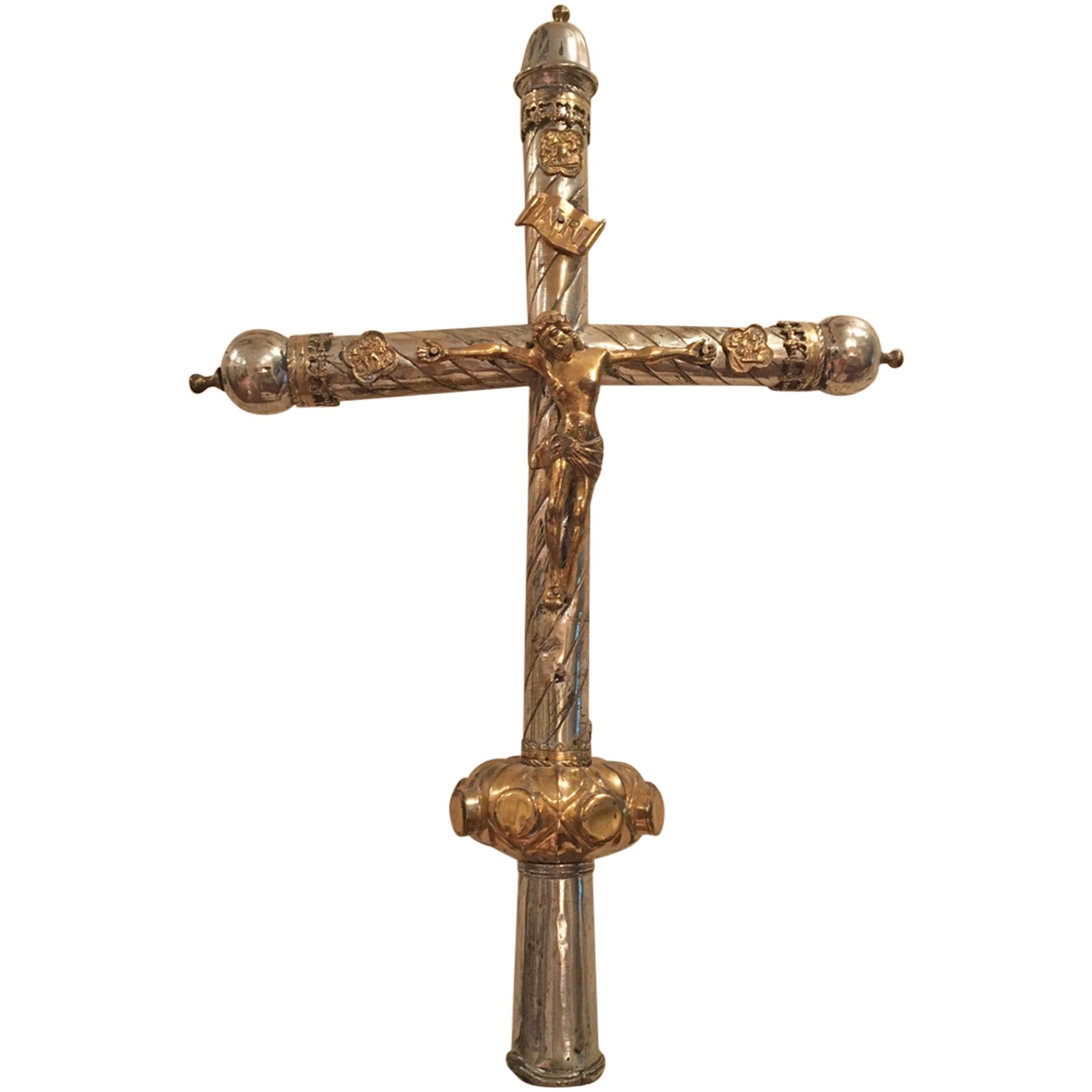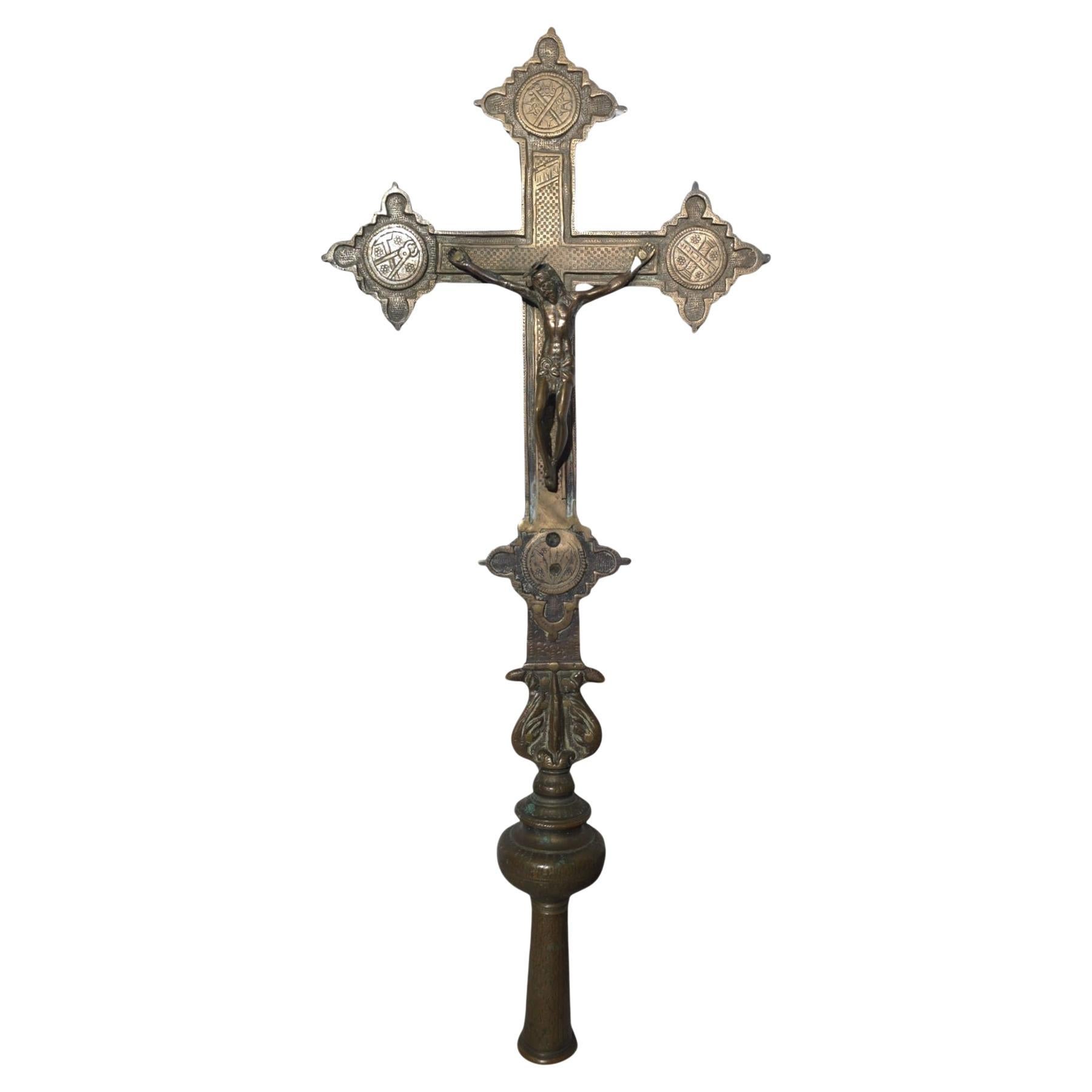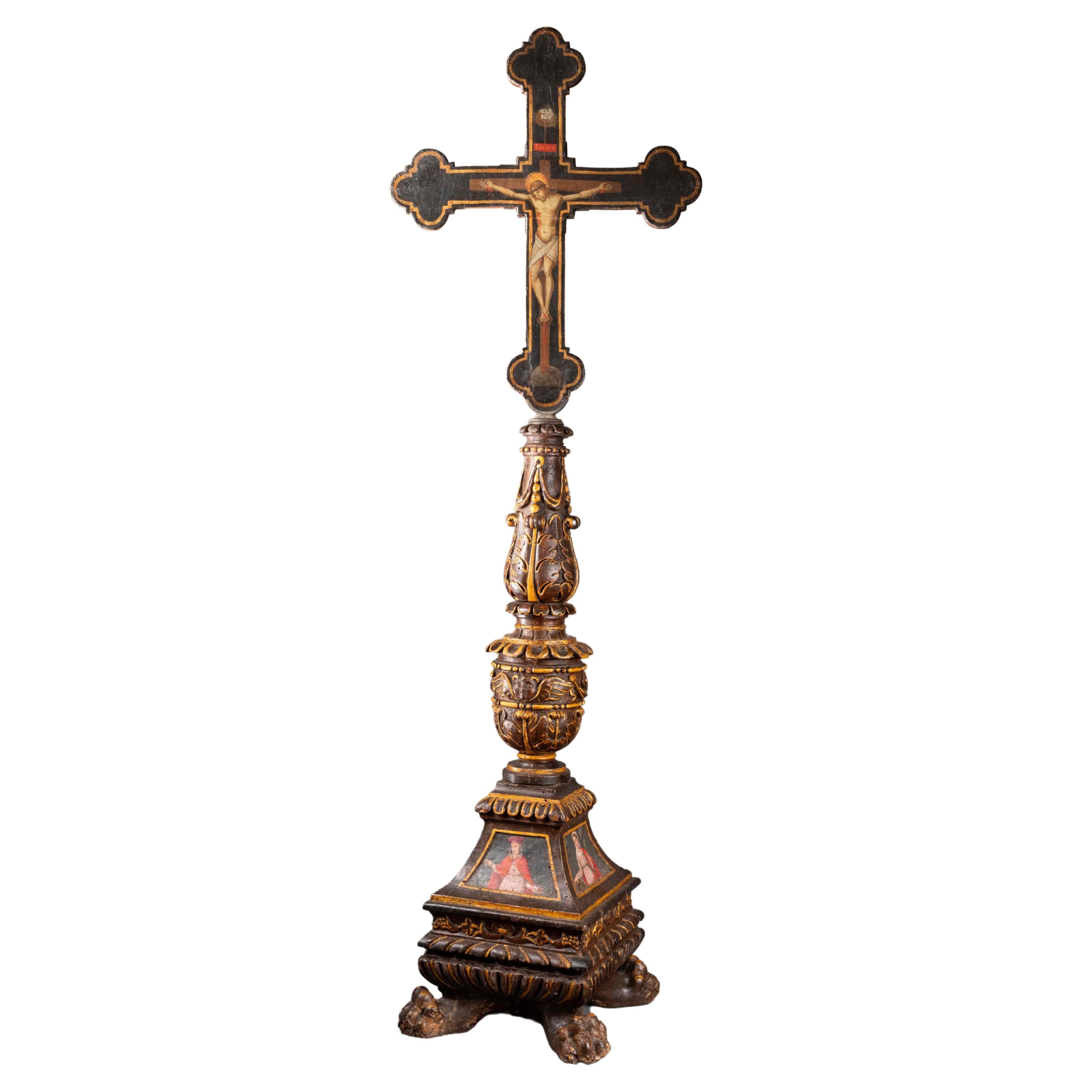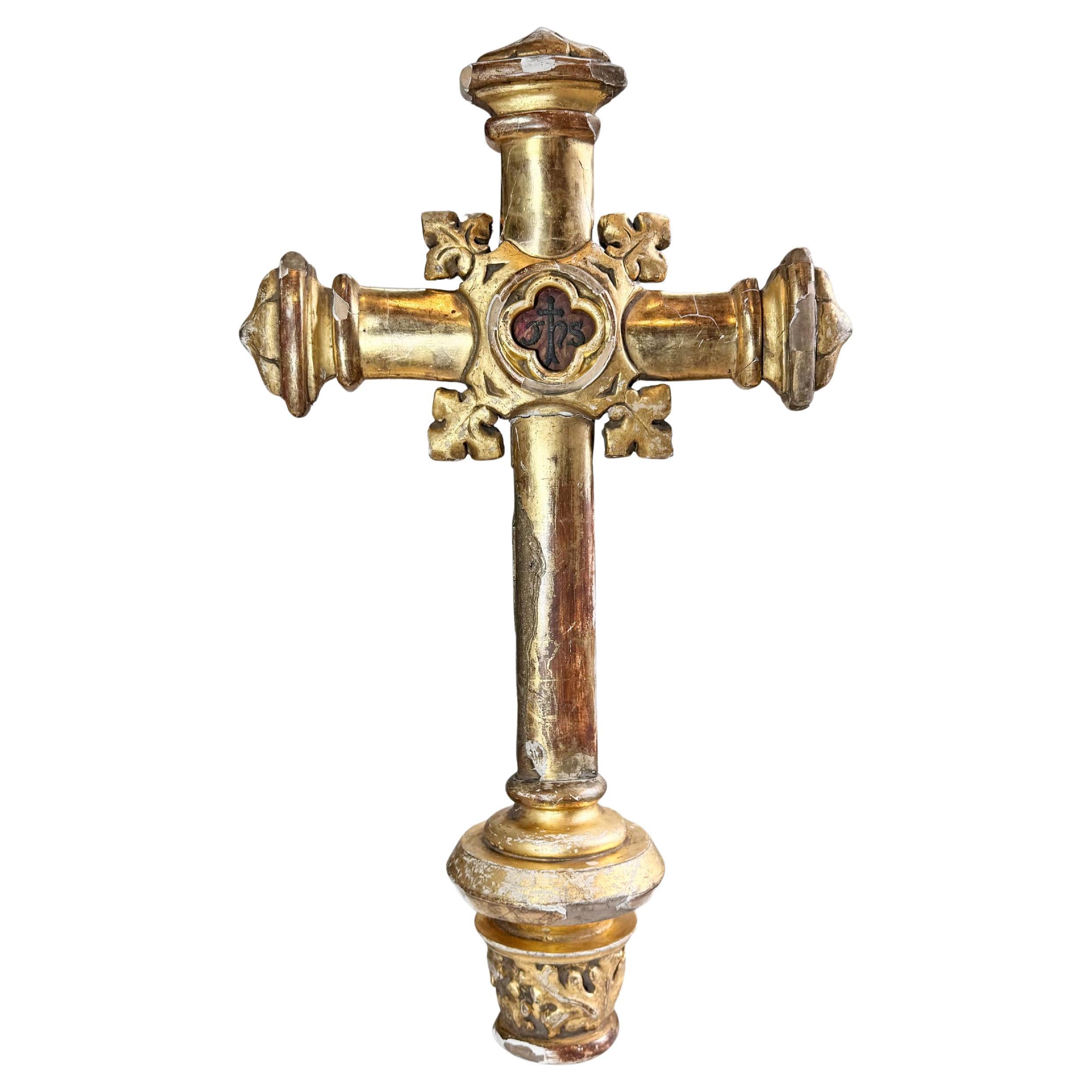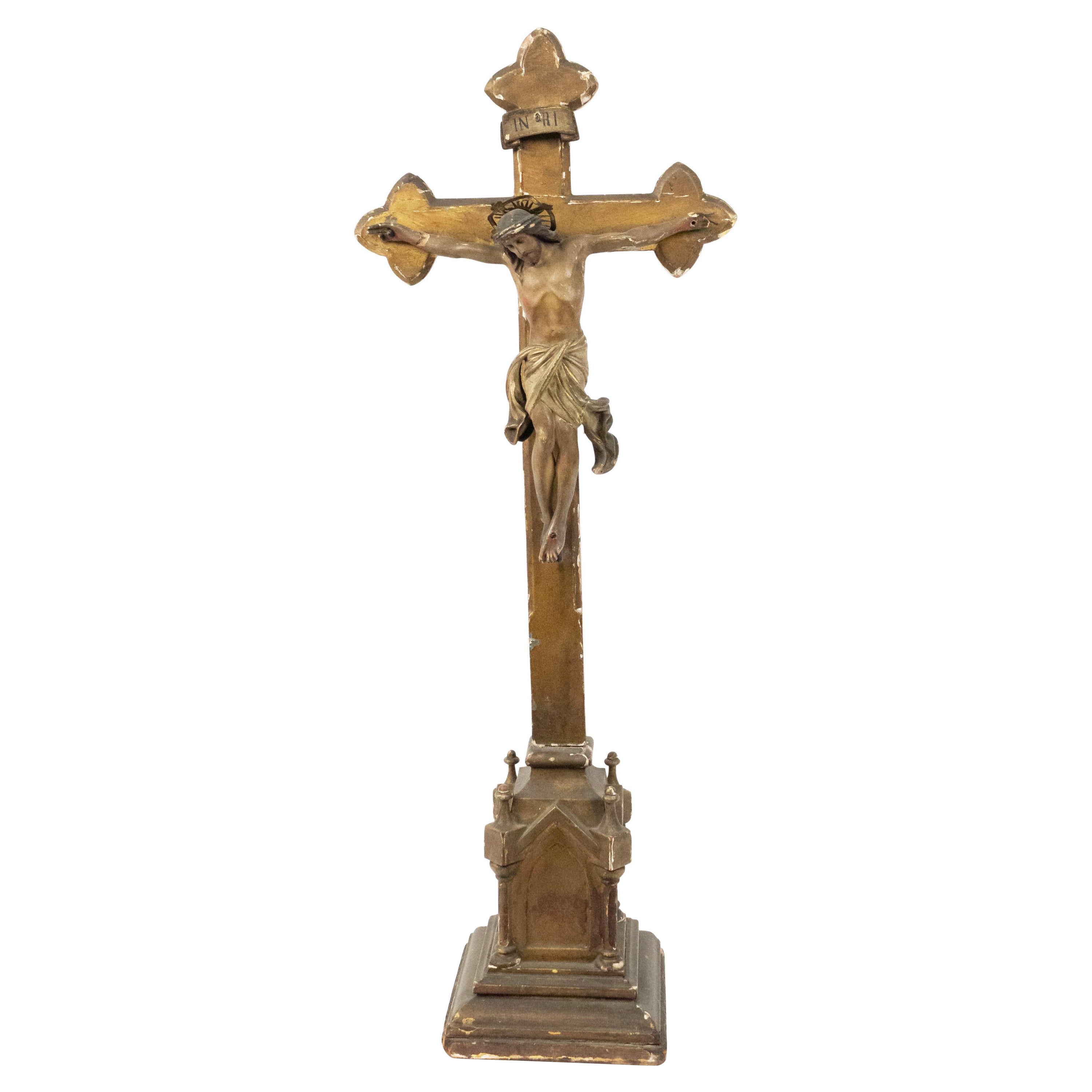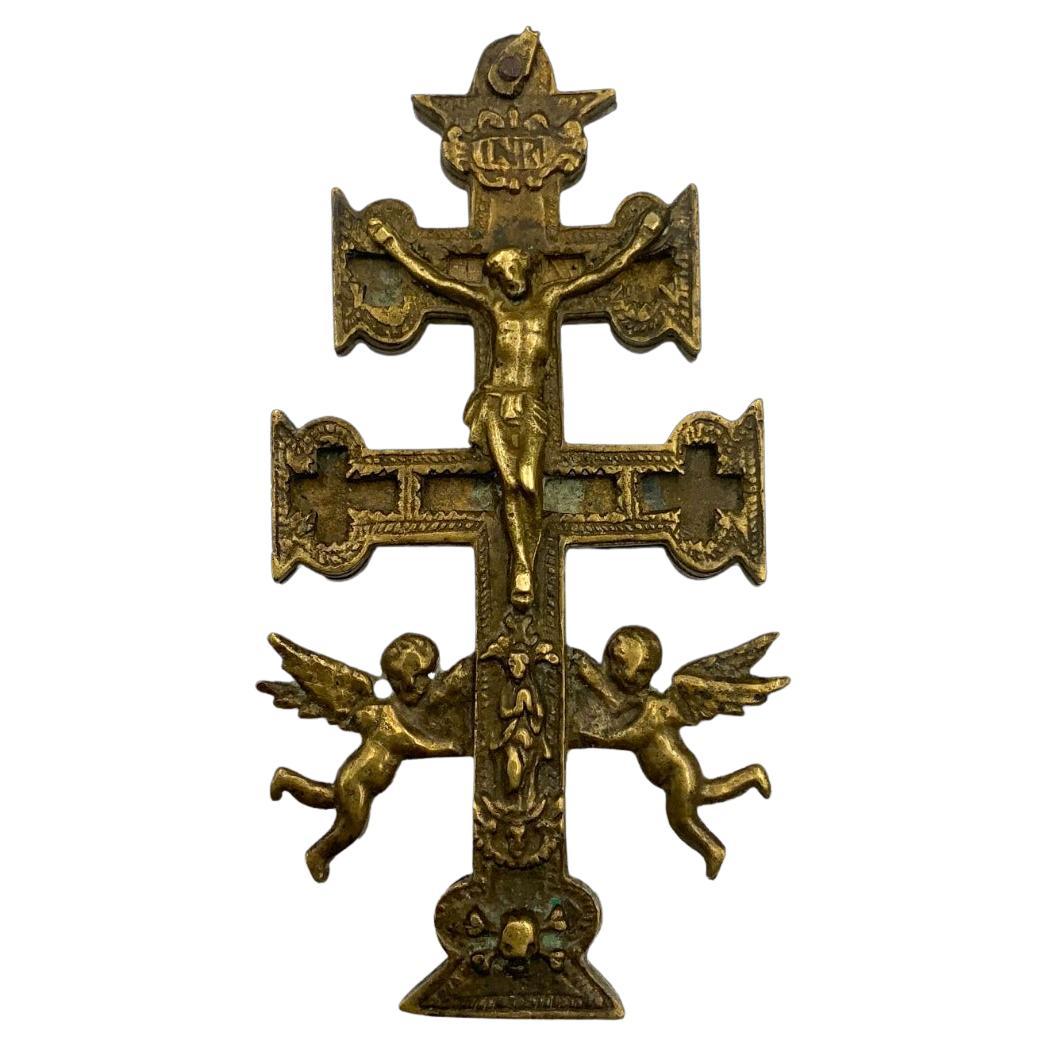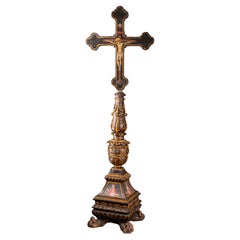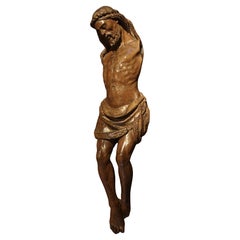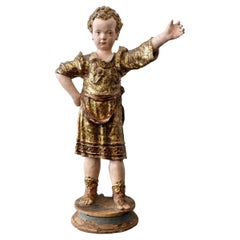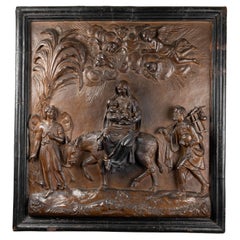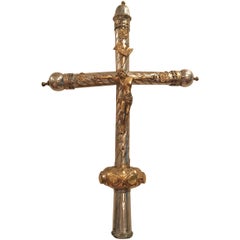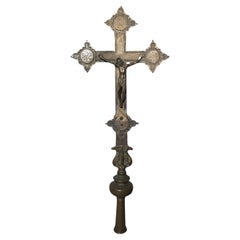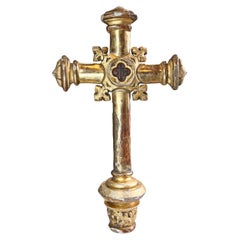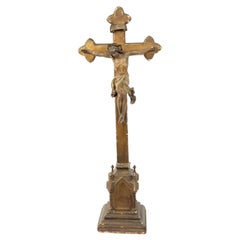Items Similar to Paolo di Giovanni Sogliani - Processional Cross Florence, around 1515
Want more images or videos?
Request additional images or videos from the seller
1 of 10
Paolo di Giovanni Sogliani - Processional Cross Florence, around 1515
$119,670.27
£88,895.03
€100,000
CA$165,093.52
A$181,483.20
CHF 95,379.24
MX$2,203,867.02
NOK 1,189,832.10
SEK 1,127,282.25
DKK 761,251.81
About the Item
Paolo di Giovanni Sogliani (Florence 1455-1522)
Processional Cross
Florence, around 1515
Enameled, chiseled, engraved, stippled, and gilded copper; wooden core ; Inscription: "OPA" 46.5 x 33 x 5 cm
Provenance:
Opera of Santa Maria del Fiore, Florence. Private collection in Umbria, Italy (since 1980)
Exhibitions:
A. Del Priori, in Secret Renaissance, curated by Vittorio Sgarbi, pp. 188-191, no. 10
Composed of two gilded copper parts welded around a wooden core, the cross is entirely decorated with stars on a blue enamel background. The front features a figure of Christ in the round, with reliefs of God the Father blessing, the Virgin Mary, Saint John, and Saint Philip the Apostle at the ends of the cross. Behind the figure of Christ is a relief depicting the symbolic image of a pelican sacrificing itself to feed its young with its entrails. At Christ's feet, the sun and moon symbolize the eclipse that accompanied Jesus' agony.
On the back, the four evangelists, Saint Anthony the Abbot, and the Agnus Dei, symbol of the Arte della Lana (one of the seven major arts of the Arti of Florence), are depicted, which exercised its patronage over the Florentine cathedral. Additionally, a golden tondo on the starry background houses the OP(er)A brand. Another element linking this cross to the opera of the Florentine cathedral is the presence of Saint Philip and Saint Anthony the Abbot. The relics of these two saints are kept in Santa Maria del Fiore, for whom two precious reliquaries were commissioned.
The iconographic program invites the faithful to respect the teachings of the Gospels and, through sacrifice (symbols of the pelican and the Lamb), to follow the path of Redemption leading to Dante's Paradise, particularly the eighth heaven, the "fixed stars," where the multitude of triumphant souls' lights reflect the light Christ transmits to them.
Characterized by archaic features typical of Renaissance goldsmithery, this piece echoes the style of the mid-Quattrocento Florentine masters such as Mino da Fiesole, Rossellino, and Gregorio di Lorenzo. The morphology of Christ reveals the influence of Donatello, as well as the new language of Benedetto da Maiano and Sangallo, evident in the athletic rendering of the body with marked abdominals and vigorous pectorals. The frontality of this Christ, with his head falling forward instead of resting on the side, is reminiscent of Antonio del Pollaiolo's Crucifix in San Lorenzo in Florence. The long and tied perizoma at the front seems to be a compromise between 15th-century models and contemporary works.
Paolo di Giovanni Sogliani, a pupil elected as the goldsmith of the Duomo Opera in 1501, is the artist to whom this cross should be attributed, based on numerous stylistic comparisons. The figures of the Evangelists and other Saints repeat the faces of the two angels on the Reliquiario del Libretto (1501). This cross is stylistically very close to the works created by Sogliani at the beginning of the 16th century. However, the presence of Saint Anthony the Abbot dates it closer to 1514, when the Saint's reliquary was completed and the silver cross decorated with the same starry background was commissioned, indicating a possible simultaneous creation of the three works.
- Dimensions:Height: 18.31 in (46.5 cm)Width: 13 in (33 cm)Depth: 1.97 in (5 cm)
- Style:Renaissance (Of the Period)
- Materials and Techniques:
- Place of Origin:
- Period:
- Date of Manufacture:16th century
- Condition:Wear consistent with age and use.
- Seller Location:Bruxelles, BE
- Reference Number:1stDibs: LU6666240628172
About the Seller
5.0
Vetted Professional Seller
Every seller passes strict standards for authenticity and reliability
1stDibs seller since 2022
15 sales on 1stDibs
Typical response time: <1 hour
- ShippingRetrieving quote...Shipping from: Bruxelles, Belgium
- Return Policy
Authenticity Guarantee
In the unlikely event there’s an issue with an item’s authenticity, contact us within 1 year for a full refund. DetailsMoney-Back Guarantee
If your item is not as described, is damaged in transit, or does not arrive, contact us within 7 days for a full refund. Details24-Hour Cancellation
You have a 24-hour grace period in which to reconsider your purchase, with no questions asked.Vetted Professional Sellers
Our world-class sellers must adhere to strict standards for service and quality, maintaining the integrity of our listings.Price-Match Guarantee
If you find that a seller listed the same item for a lower price elsewhere, we’ll match it.Trusted Global Delivery
Our best-in-class carrier network provides specialized shipping options worldwide, including custom delivery.More From This Seller
View Allrenaissance wooden candelabrum and painted cross - Umbria, 16th century
Located in Bruxelles, BE
Base of a carved wooden candelabrum, polychrome and gilded; cross painted on both sides.
Umbria or Tuscany, 16th century
136 x 43,5 x 30 cm
(The cross and the base of the candelabrum were later assembled)
The base of the candelabrum is intricately carved and adorned with polychrome and gilded finishes. The shafts take on the shape of balusters reminiscent of ancient columns, feature ornate foliage decorations, garlands and winged cherub faces. The feet are crafted in the likeness of lion paws. The base is further embellished with depictions of four saint martyrs, among them Saint Barbara and Saint Catherine of Alexandria. The plasticity of the figures, outlined with strong contour lines, the clear and vibrant colors, are stylistic elements linked to the Umbrian tradition of the sixteenth century.The precisely defined and elegant drawing, along with the clear color palette applied with refined chiaroscuro modulations, became the signature of a style that would leave a lasting mark on the era to come. This is exemplified by a preference for vibrant, multicolored images, accentuated in this case by the use of red and pink in the saint's attire.
A notable addition, introduced later, is a polylobed cross painted on both sides. On one side, the Crucifixion is vividly portrayed:The treatment of the corpus itself is in line with High Medieval practice, emphasizing pathos by showing Jesus dead, his arms sagging from the weight of the body. The upper section displaying a pelican pecks at her breast to feed her young with her own blood; a symbol of the sacrifice of Christ on the cross whose body and blood similarly nourishes the celebrant during Mass.
The lower part depicts Golgotha. On the reverse side, the Resurrection is artistically presented in a Renaissance iconography, reminiscent of the renowned composition painted by Piero della Francesca, now housed in the Civic Museum of Sansepolcro. In terms of composition, with the frontal depiction of Christ holding the banner, this motif became particularly widespread in central Italy, spanning from Tuscany to Umbria throughout the 16th century..
The double-sided construction suggests that it may also have been carried in liturgical processions. In Umbria from the 14th century, the use of portable crosses painted on both sides had become a widespread practice, aimed at satisfying the monastic clientele that had significantly increased following the establishment of new religious communities.
The earliest surviving Tuscan painted crucifix represent Christ as Christus Triumphans, or the “Triumphant Christ” with his head up and eyes open. This form was supplanted in the 13th century with the Christus Patiens, or “Suffering Christ” type who is shown often with his head fallen on his shoulder and his eyes closed, as In our cross. The iconography of the suffering Christ appears to have developed out of a new interest in Christ’s human nature, the development of the feast of Corpus Christi and with increased importance given to the Eucharist. The process of humanizing the figure of Christ reaches its peak with the abandonment of all the previous expressive conventions in favor of more realistic details we can observe in this Crucifix, such as the swollen belly, the arms stretched to the limit of muscle tearing, the body falling heavily forward, the abundant blood on
the wounds, and the cross firmly embedded in the rock of Calvary.
It's worth noting that Renaissance candelabra...
Category
Antique 16th Century Italian Renaissance Figurative Sculptures
Materials
Wood, Giltwood
Christ - Umbria, second half of the 15th century
Located in Bruxelles, BE
Christ
Umbria, Orvieto?
Second half of the 15th century
77 x 16.5 cm
Category
Antique 15th Century and Earlier Italian Renaissance Figurative Sculptures
Materials
Walnut
Cercle of Romano Alberti, Page, Around 1530-1540
Located in Bruxelles, BE
Cercle of Romano Alberti, dit Il Nero da Sansepolcro ( San Sepolcro, 1521-1568 )
Page
Mixed media : wood core, papier mâché, stucco, polychrome and gilded
Italy, around 1530-154...
Category
Antique 16th Century Italian Renaissance Figurative Sculptures
Materials
Stucco, Wood, Paper
$12,445 Sale Price
35% Off
Large Terracotta Relief - Lombardy, First Half of 17th Century
Located in Bruxelles, BE
Large Terracotta relief of the flight into Egypt
Lombardy, first half of 17th century
Painted terracotta
91 x 85 x 11,5 cm
This event in the early life of Christ is recounted i...
Category
Antique 17th Century Italian Baroque Figurative Sculptures
Materials
Terracotta
$62,228 Sale Price
20% Off
Circle of Pierpaolo and Jacobello Dalle Masegne (Venice, late 14th century)
Located in Bruxelles, BE
Circle of Pierpaolo and Jacobello Dalle Masegne (Venice, late 14th century)
San Bartolomeo
high relief 'en applique'
white marble
52 x 30 x 14 cm
Provenance :
Collection South of...
Category
Antique 15th Century and Earlier Italian Gothic Figurative Sculptures
Materials
Marble
Marble Roman relief representing a Christogram
Located in Bruxelles, BE
Marble Roman relief representing a Christogram
Roman relief - 4th century
25 x 22 x 8 cm
Provenance :
Collection of the Château de B. À Nevers by Georges C.S., scholar born in 1833 and deceased in 1909
The entire castle and its collections were acquired in 1938 by the current owners of the estate
A christogram is a monogram or combination of letters that forms an abreviation for the name of Jesus Christ.
This rare fragment combines chi (X) and rho (P), the first two letters of Christ's name in Greek and it is one of the oldest and most popular early christian symbol. The monogram of Christ, or chrismon, is also a powerful symbol of imperial victory: it appeared to Emperor Constantine the Great before his battle against Maxentius in ad 312, promising victory in the name of Christ. In Plato's Timaeus, it is explained that the two bands which form the "world soul" (anima mundi...
Category
Antique 15th Century and Earlier Italian Classical Roman Figurative Scul...
Materials
Marble
$3,513 Sale Price
30% Off
You May Also Like
Period Renaissance Early 16th Century Processional Cross, France
Located in Vero Beach, FL
Exceptional Period Renaissance processional cross early 16th century, France
Extremely rare and beautiful processional cross from the early period of the French Renaissance. This ...
Category
Antique 16th Century French Renaissance Religious Items
Materials
Bronze
17th-Century Italian Processional Cross in Bronze
Located in Madrid, ES
This magnificent 17th-century Italian processional cross is crafted from bronze, showcasing the religious and artistic heritage of the period. The cross features intricate detailing,...
Category
Antique 17th Century Religious Items
Materials
Bronze
18th Century Water Gilded Processional Cross with Embroidered IHS
Located in Hastings, GB
Glorious 18th century water gilded baroque processional cross, with embroidered IHS panels inset.
Time worn patina, gesso over wood.
Height 61 cm, Width 37 cm, Depth 13 cm
Category
Antique Mid-18th Century Italian Baroque Religious Items
Materials
Gesso, Wood
Italian Renaissance Carved Wood Crucifix
Located in Queens, NY
Italian Renaissance style (19th Cent) carved wood crucifix on square base with figure
Category
Antique 19th Century Italian Renaissance Religious Items
Materials
Wood
Cross of Caravaca 17th Century
Located in Madrid, ES
Cross of caravaca xvii century
Very beautiful cross of Caravaca made in bronze. 17th century. Measurements: 12 x 6cm
Good condition.
Category
Antique 17th Century Italian Gothic Religious Items
Materials
Bronze
Cross of Caravaca 17th Century
Located in Madrid, ES
Cross of caravaca xvii century.
Very beautiful cross of caravaca made in bronze. 17th Century. Measurements: 14x6 cm.
Good condition.
Category
Antique 17th Century Italian Gothic Religious Items
Materials
Bronze
More Ways To Browse
Antique Wood Cross
Antique Exercise
Antique Reliquary
Antique Silver Cross
Renaissance Copper
Antique Wooden Crosses
Copper Cross
Christ Of Saint John Of The Cross
Cross Renaissance
Used Processional Cross
Agnus Dei
Cross Processional
Santa Maria Del Fiore
16th Century Cross
Antique Gold Pan
Art Deco Goddess
Art Deco Resin Sculpture
Black Egypt Sculpture
